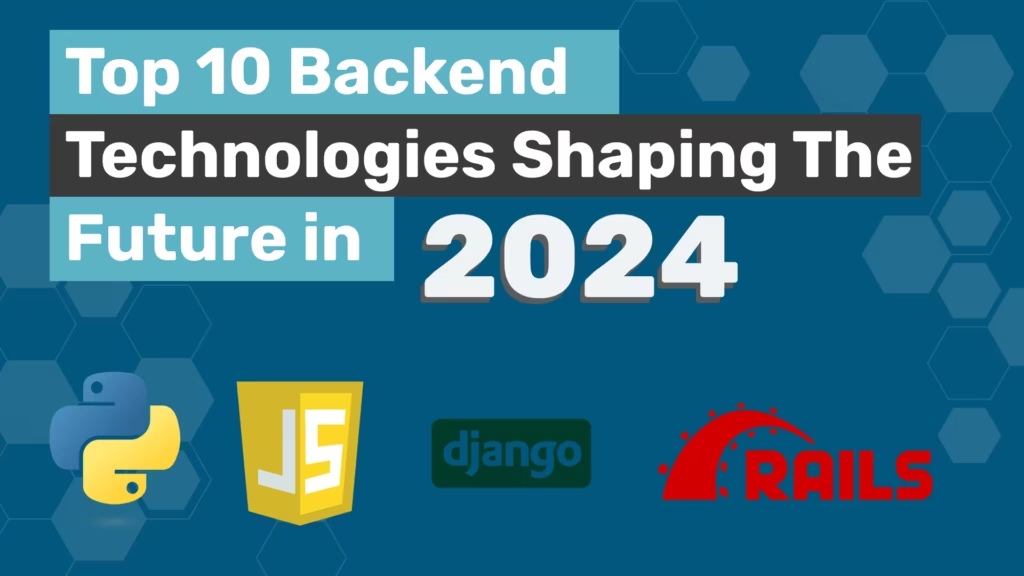
In the fast-evolving world of backend development, choosing the right technology stack can make or break a project. A solid backend technology supports scalable, secure, and high-performing applications. In this article, we’ll cover the top backend technologies of 2024, including frameworks, databases, and languages that are powering web applications worldwide.
Table of contents
Programming Languages
1. Python
Python’s simplicity and versatility have made it a top choice for backend development. Its extensive libraries, such as Django and Flask, streamline web development, while frameworks like TensorFlow and PyTorch empower machine learning and AI applications.
Key Features
- Built-in admin panel and ORM support
- High security with protections against SQL injection, XSS, and CSRF attacks
- Batteries-included philosophy with a vast library of pre-built components
2.JavaScript (Node.js)
Node.js has revolutionized server-side JavaScript development. Its non-blocking, event-driven architecture enables efficient handling of multiple requests, making it ideal for real-time applications, APIs, and microservices.
Key Features
- Non-blocking I/O model for real-time applications
- Single-threaded with high scalability
- Strong support from a vast community of JavaScript developers
3.Java
Java’s robustness and scalability have solidified its position as a cornerstone of enterprise applications. Its strong type system, object-oriented paradigm, and vast ecosystem of frameworks like Spring Boot make it a reliable choice for complex backend systems.
Key Features
- Platform independence with JVM compatibility
- Strong security and reliability for enterprise applications
- Spring Boot’s comprehensive tools and libraries for rapid development
4. Ruby
Ruby’s elegant syntax and focus on developer productivity have made it a popular choice for web development. The Ruby on Rails framework provides comprehensive tools for rapidly building web applications
Key Features
- Dynamically typed for faster, flexible coding.
- Fully object-oriented for reusable code.
- Automatic memory management with garbage collection.
Frameworks
5. Express.js
A minimalist Node.js framework, Express.js offers flexibility and control over routing, middleware, and HTTP requests. It’s widely used for building APIs and web applications.
Key Features
- Simple routing and middleware support
- Fast and flexible, ideal for REST APIs and single-page applications
- Works well with front-end libraries and frameworks like React and Angular
6. Django
Django, a high-level Python framework, promotes rapid development through its built-in features like ORM, a templating engine, and an admin interface. It’s ideal for complex web applications.
Key Features
- Built-in admin panel and ORM support
- High security with protections against SQL injection, XSS, and CSRF attacks
- Batteries-included philosophy with a vast library of pre-built components
7. Ruby on Rails
A full-stack framework, Ruby on Rails emphasizes convention over configuration, making development efficient. It’s suitable for building web applications quickly.
Key Features
- Extensive libraries (gems) for additional functionality
- Emphasis on convention over configuration reduces setup time
- Integrated testing environment for streamlined testing
8. Spring Boot
.Spring Boot is a project under the broader Spring Framework developed by Pivotal Software (now a part of VMware) to simplify the process of building stand-alone, production-grade Spring applications. It helps developers create applications that can run independently, without the need for a complex server setup or XML configuration. Let’s explore Spring Boot’s core features and see why it has become a popular choice for building modern Java applications.
Key Features
- Configures the application automatically based on dependencies, reducing setup time.
- Runs with an embedded server (e.g., Tomcat), eliminating the need for an external server.
- Provides starter packs to simplify dependency management.
- Allows quick testing and prototyping using Groovy scripts.
- Offers health checks, metrics, and monitoring for production insights.
9. Laravel (PHP)
Laravel is one of the top 10 backend technologies of 2024, known for its elegant syntax, powerful tools, and developer-friendly features that make it ideal for building modern web applications. Created by Taylor Otwell, Laravel simplifies complex web development tasks by providing tools for routing, authentication, database migrations, and more. Following the Model-View-Controller (MVC) architectural pattern, Laravel helps developers organize code efficiently, making it easier to maintain and scale applications. With built-in support for RESTful APIs, a templating engine called Blade, and advanced features like task scheduling, queues, and broadcasting, Laravel enables the creation of secure, scalable, and high-performance applications. Its active community and rich ecosystem, including tools like Laravel Forge and Laravel Vapor for streamlined deployment, solidify Laravel’s place as a leading choice in PHP development for 2024.
Key Features
- Elegant syntax and developer-friendly design.
- Built-in tools for routing, authentication, and database migrations.
- Follows MVC architecture for organized, maintainable code.
- Supports RESTful APIs and Blade templating engine.
10. ASP.NET Core
ASP.NET Core is a modern, open-source, cross-platform framework developed by Microsoft for building high-performance web applications. Known for its speed, flexibility, and powerful integration with the .NET ecosystem, ASP.NET Core enables developers to create secure and scalable applications for the web, cloud, and enterprise environments. Designed to work on Windows, macOS, and Linux, it supports a range of deployment options and can run on Docker, Kubernetes, and cloud platforms like Azure and AWS.
Key Features
- Develop for Windows, macOS, Linux, and even web assembly using a single codebase.
- Smaller footprint compared to ASP.NET MVC, allowing for more targeted deployments.
- Designed for deployment on cloud platforms like Azure, AWS, and GCP
- Well-suited for building modern web APIs and microservices architectures.

